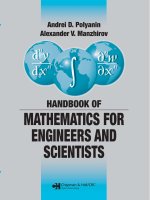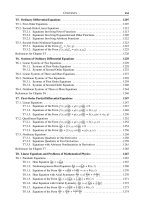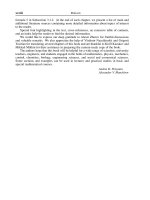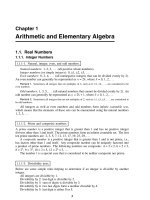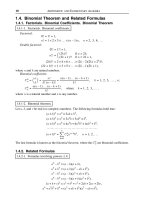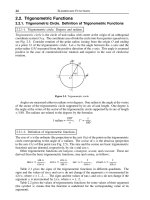Handbook of mathematics for engineers and scienteists part 5 potx
Bạn đang xem bản rút gọn của tài liệu. Xem và tải ngay bản đầy đủ của tài liệu tại đây (337.39 KB, 7 trang )
xxviii PREFACE
formula 5 in Subsection 3.1.2. At the end of each chapter, we present a list of main and
additional literature sources containing more detailed information about topics of interest
to the reader.
Special font highlighting in the text, cross-references, an extensive table of contents,
and an index help the reader to find the desired information.
We would like to express our deep gratitude to Alexei Zhurov for fruitful discussions
and valuable remarks. We also appreciate the help of Vladimir Nazaikinskii and Grigorii
Yosifian for translating several chapters of this book and are thankful to Kirill Kazakov and
Mikhail Mikhin for their assistance in preparing the camera-ready copy of the book.
The authors hope that this book will be helpful for a wide range of scientists, university
teachers, engineers, and students engaged in the fields of mathematics, physics, mechanics,
control, chemistry, biology, engineering sciences, and social and economical sciences.
Some sections and examples can be used in lectures and practical studies in basic and
special mathematical courses.
Andrei D. Polyanin
Alexander V. Manzhirov
Main Notation
Special symbols
= equal to
≡ identically equal to
≠ not equal to
≈ approximately equal to
∼ of same order as (used in comparisons of infinitesimals or infinites)
< less than; “a less than b” is written as a < b (or, equivalently, b > a)
≤ less than or equal to; a less than or equal to b is written as a ≤ b
much less than; a much less than b is written as a b
> greater than; a greater than b is written as a > b (or, equivalently, b < a)
≥ greater than or equal to; a greater than or equal to b is written as a ≥ b
much greater than; a much greater than b is written as a b
+ plus sign; the sum of numbers a and b is denoted by a + b and has the property
a + b = b + a
– minus sign; the difference of numbers a and b is denoted by a – b
⋅ multiplication sign; the product of numbers
a and b is denoted by either ab
or a ⋅ b (sometimes a × b) and has the property ab = ba; the inner product of
vectors a and b is denoted by a ⋅ b
× multiplication sign; the product of numbers a and b is sometimes denoted by
a × b; the cross-product of vectors a and b is denoted by a × b
: division sign; the ratio of numbers a and b is denoted by a:b or a/b
! factorial sign: 0!=1!=1, n!=1 ⋅ 2 ⋅ 3 (n – 1)n, n = 2, 3, 4,
!! double factorial sign: 0!! = 1!! = 1,(2n)!! = 2 ⋅ 4 ⋅ 6 (
2n), (2n + 1)!! =
1 ⋅ 3 ⋅ 5 (2n + 1), where n = 1, 2, 3,
% percent sign; 1% is one hundredth of the entire quantity
∞ infinity
→ tends (infinitely approaches) to; x → a means that x tends to a
=⇒ implies; consequently
⇐⇒ is equivalent to (if and only if )
∀ for all, for any
∃ there exists
belongs to; a A means that a is an element of the set A
does not belong to; a A means that a is not an element of the set A
∪ union (Boolean addition); A ∪ B stands for the union of sets A and B
∩ intersection (Boolean multiplication); A ∩B stands for the intersection (com-
mon part) of sets A and B
⊂ inclusion; A ⊂ B means that the set A is part of the set B
⊆ nonstrict inclusion; A ⊆B means that the set A is part of the set B or coincides
with B
∅ empty set
sum,
n
k=1
a
k
= a
1
+ a
2
+ ···+ a
n
product,
n
k=1
a
k
= a
1
⋅ a
2
⋅ ⋅ a
n
∂ symbol used to denote partial derivatives and differential operators; ∂
x
is the
operator of differentiation with respect to x
xxix
xxx MAIN NOTATION
∇ vector differential operator “nabla”; ∇a is the gradient of a scalar a
integral;
b
a
f(x) dx is the integral of a function f(x) over the interval [a, b]
contour integral (denotes an integral over a closed contour)
⊥ perpendicular
parallel
Roman alphabet
Arg z argument of a complex number z = x + iy;bydefinition, tan(Arg z)=y/x
arg z principal value of Arg z;bydefinition, arg z =Argz,where–π <Argz ≤ π
√
a square root of a number a,defined by the property (
√
a )
2
= a
n
√
anth root of a number a (n = 2, 3, , a≥ 0), defined by the property (
n
√
a )
n
=a
|a| absolute value (modulus) of a real number a, |a| =
a if a ≥ 0
–a if a < 0
a vector, a = {a
1
, a
2
, a
3
},wherea
1
, a
2
, a
3
are the vector components
|a| modulus of a vector a, |a| =
√
a ⋅ a
a ⋅ b inner product of vectors a and b, denoted also by (a ⋅ b)
a × b cross-product of vectors a and b
[abc] triple product of vectors a, b, c
(a, b) interval (open interval) a < x < b
(a, b] half-open interval a < x ≤ b
[a, b) half-open interval a ≤ x < b
[a, b] interval (closed interval) a ≤ x ≤ b
arccos x arccosine, the inverse function of cosine: cos(arccos x)=x, |x| ≤ 1
arccot x arccotangent, the inverse function of cotangent: cot(arccot x)=x
arcsin x arcsine, the inverse function of sine: sin(arcsin x)=x, |x| ≤ 1
arctan
x arctangent, the inverse function of tangent: tan(arctan x)=x
arccosh x hyperbolic arccosine, the inverse function of hyperbolic cosine; also denoted
by arccosh x =cosh
–1
x; arccosh x =ln
x +
√
x
2
– 1
(x ≥ 1)
arccoth x hyperbolic arccotangent, the inverse function of hyperbolic cotangent; also
denoted by arccoth x =coth
–1
x; arccoth x =
1
2
ln
x + 1
x – 1
(|x| > 1)
arcsinh x hyperbolic arcsine, the inverse function of hyperbolic sine; also denoted by
arcsinh x =sinh
–1
x;arcsinhx =ln
x +
√
x
2
+ 1
arctanh x hyperbolic arctangent, the inverse function of hyperbolic tangent; also denoted
by arctanh x =tanh
–1
x;arctanhx =
1
2
ln
1 + x
1 – x
(|x| < 1)
C
k
n
binomial coefficients, also denoted by
n
k
, C
k
n
=
n!
k!(n – k)!
, k =1, 2, , n
C Euler constant, C = lim
n→∞
1 +
1
2
+
1
3
+ ···+
1
n
–lnn
= 0.5772156
cos x cosine, even trigonometric function of period 2π
cosec x cosecant, odd trigonometric function of period 2π:cosecx =
1
sin x
cosh x hyperbolic cosine, cosh x =
1
2
(e
x
+ e
–x
)
cot x cotangent, odd trigonometric function of period π,cotx =cosx/sin x
coth x hyperbolic cotangent, coth x =coshx/sinh x
det A determinant of a matrix A =(a
ij
)
MAIN NOTATION xxxi
div a divergence of a vector a
e the number “e” (base of natural logarithms), e = 2.718281 ;definition:
e = lim
n→∞
1 +
1
n
n
erf x Gauss error function, erf x =
2
√
π
x
0
exp
–ξ
2
dξ
erfc x complementary error function, erfc x =
2
√
π
∞
x
exp
–ξ
2
dξ
exp x exponential (exponential function), denoted also by exp x = e
x
grad a gradient of a scalar a, denoted also by ∇a
H
n
(x) Hermite polynomial, H
n
(x)=(–1)
n
e
x
2
d
n
dx
n
e
–x
2
I
ν
(x) modified Bessel function of the first kind, I
ν
(x)=
∞
n=0
(x/2)
ν+2n
n! Γ(ν + n + 1)
Im z imaginary part of a complex number; if z = x + iy,thenImz = y
inf A infimum of a (numerical) set A;ifA =(a, b)orA =[a, b), then inf A = a
J
ν
(x) Bessel function of the first kind, J
ν
(x)=
∞
n=0
(–1)
n
(x/2)
ν+2n
n! Γ(ν + n + 1)
K
ν
(x) modified Bessel function of the second kind, K
ν
(x)=
π
2
I
–ν
(x)–I
ν
(x)
sin(πν)
lim
x→a
f(x) limit of a function f (x)asx → a
ln x natural logarithm (logarithm to base e)
log
a
x logarithm to base a
max
a≤x≤b
f(x) maximum of a function f(x) on the interval a ≤ x ≤ b
min
a≤x≤b
f(x) minimum of a function f(x) on the interval a ≤ x ≤ b
n! factorial: 0!=1!=1, n!=1 ⋅ 2 ⋅ 3 (n – 1)n, n = 2, 3, 4,
P
n
(x) Legendre polynomial, P
n
(x)=
1
n! 2
n
d
n
dx
n
(x
2
– 1)
n
R set of real numbers, R = {–∞ < x < ∞}
Re z real part of a complex number; if z = x + iy,thenRez = x
r, ϕ, z cylindrical coordinates, r =
x
2
+ y
2
and x = r cos ϕ, y = r sin ϕ
r, θ, ϕ spherical coordinates, r =
x
2
+y
2
+z
2
and x = r sin θ cos ϕ, y =sinθ sin ϕ,
z = r cos θ
rank A rank of a matrix A
curl a curl of a vector a, also denoted by rot a
sec x secant, even trigonometric function of period 2π:secx =
1
cos x
sign x “sign” function: it is equal to 1 if x > 0,–1 if x < 0,and0 if x = 0
sin x sine, odd trigonometric function of period 2π
sinh x hyperbolic sine, sinh x =
1
2
(e
x
– e
–x
)
sup A supremum of a (numerical) set A;ifA =(a, b)orA =(a, b], then sup A = b
tan x tangent, odd trigonometric function of period π,tanx =sinx/cos x
tanh x hyperbolic tangent, tanh x =sinhx/cosh x
x independent variable, argument
x, y, z spatial variables (Cartesian coordinates)
xxxii MAIN NOTATION
Y
ν
(x) Bessel function of the second kind; Y
ν
(x)=
J
ν
(x)cos(πν)–J
–ν
(x)
sin(πν)
y dependent variable, function; one often writes y = y(x)ory = f (x)
y
x
first derivative of a function y = f(x), also denoted by y
,
dy
dx
, f
(x)
y
xx
second derivative of a function y = f (x), also denoted by y
,
d
2
y
dx
2
, f
(x)
y
(n)
x
nth derivative of a function y = f(x), also denoted by
d
n
y
dx
n
z = x + iy complex number; x is the real part of z, y is the imaginary part of z, i
2
=–1
¯z = x – iy complex conjugate number, i
2
=–1
|z| modulus of a complex number; if z = x + iy,then|z| =
x
2
+ y
2
.
Greek alphabet
Γ(α) gamma function, Γ(α)=
∞
0
e
–t
t
α–1
dt
γ(α, x) incomplete gamma function, γ(α, x)=
x
0
e
–t
t
α–1
dt
Φ(a, b; x) degenerate hypergeometric function, Φ(a, b; x)=1+
∞
n=1
a(a+1) (a+n–1)
b(b+1) (b+n–1)
x
n
n!
Δ Laplace operator; in the two-dimensional case, Δw =
∂
2
w
∂x
2
+
∂
2
w
∂y
2
,wherex
and y are Cartesian coordinates
Δx increment of the argument
Δy increment of the function; if y = f (x), then Δy = f (x + Δx)–f (x)
δ
nm
Kronecker delta, δ
nm
=
1 if n = m
0 if n ≠ m
π the number “pi” (ratio of the circumference to the diameter), π = 3.141592
Remarks
1. If a formula or a solution contains an expression like
f(x)
a – 2
, it is often not stated
explicitly that the assumption a ≠ 2 is implied.
2. If a formula or a solution contains derivatives of some functions, then the functions
are assumed to be differentiable.
3. If a formula or a solution contains definite integrals, then the integrals are supposed
to be convergent.
4. ODE and PDE are conventional abbreviations for ordinary differential equation and
partial differential equation, respectively.
Part I
Definitions, Formulas,
Methods, and Theorems
